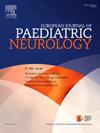Tests of dynamic balance, motor function and fear of falling as indicators of fall risk in children with Duchenne muscular dystrophy
IF 2.3
3区 医学
Q3 CLINICAL NEUROLOGY
引用次数: 0
Abstract
Objectives
This study aims to examine dynamic balance, motor function, and fear of falling (FOF) as indicators of fall risk in children with Duchenne Muscular dystrophy (DMD).
Methods
This cross-sectional study included 92 children with DMD (ages 5–15; mean age 7.44 ± 2.10; mean BMI 17.70 ± 2.96), recruited from Shenzhen Children's Hospital between August 2023 and January 2024. Data collected included demographics, clinical characteristics, and fall history over the past month and year. Dynamic balance was assessed using the four-square step test (FSST), motor function with the motor function measure (MFM-32), 6-min walk test, and timed function tests (TFTs), and FOF using Lim's single-item question.
Results
85.9 % reported falls in the past year, with 45.7 % classified as recurrent fallers (≥1 fall/week or day) and 51.1 % reporting recurrent falls (≥3) in the past month. FSST, MFM, and TFTs scores differed significantly between recurrent and non-recurrent fallers across both timeframes (FSST and MFM: p < 0.001; TFTs: p ≤ 0.01). FOF showed no significant group differences (month: p = 0.066; year: p = 0.054). FSST showed high accuracy in identifying recurrent fallers (AUC = 0.856–0.890; cut-off = 10.41s; sensitivity = 80.9 %–81.0 %; specificity = 88.0 %–95.6 %). In contrast, MFM and TFTs had limited discriminative value.
Conclusion
Dynamic balance, as assessed by the FSST, is a sensitive and specific indicator for identifying recurrent fallers in children with DMD, supporting its clinical utility in fall risk screening and prevention.
动态平衡、运动功能和对跌倒的恐惧测试作为杜氏肌营养不良儿童跌倒风险的指标
本研究旨在探讨动态平衡、运动功能和跌倒恐惧(FOF)作为杜氏肌营养不良症(DMD)儿童跌倒风险的指标。方法本横断面研究纳入92例DMD患儿(5-15岁;平均年龄7.44±2.10岁;平均BMI(17.70±2.96),于2023年8月至2024年1月在深圳儿童医院招募。收集的数据包括过去一个月和一年的人口统计、临床特征和跌倒史。采用四平方步测试(FSST)、运动功能测试(MFM-32)、6分钟步行测试和定时功能测试(TFTs)评估动态平衡,采用Lim单项问题评估FOF。结果85.9%的患者报告在过去一年中跌倒,45.7%的患者报告复发跌倒(≥1次/周或天),51.1%的患者报告在过去一个月复发跌倒(≥3次)。FSST、MFM和TFTs评分在两个时间段内复发性和非复发性跌倒者之间存在显著差异(FSST和MFM: p <;0.001;TFTs: p≤0.01)。FOF组间差异无统计学意义(月:p = 0.066;年份:p = 0.054)。FSST对复发性降压者的识别准确率较高(AUC = 0.856 ~ 0.890;截止时间= 10.41s;灵敏度= 80.9% - 81.0%;特异性= 88.0% - 95.6%)。相比之下,MFM和TFTs的鉴别价值有限。结论FSST评估的动态平衡是识别DMD儿童复发性跌倒的敏感和特异性指标,支持其在跌倒风险筛查和预防中的临床应用。
本文章由计算机程序翻译,如有差异,请以英文原文为准。
求助全文
约1分钟内获得全文
求助全文
来源期刊
CiteScore
6.30
自引率
3.20%
发文量
115
审稿时长
81 days
期刊介绍:
The European Journal of Paediatric Neurology is the Official Journal of the European Paediatric Neurology Society, successor to the long-established European Federation of Child Neurology Societies.
Under the guidance of a prestigious International editorial board, this multi-disciplinary journal publishes exciting clinical and experimental research in this rapidly expanding field. High quality papers written by leading experts encompass all the major diseases including epilepsy, movement disorders, neuromuscular disorders, neurodegenerative disorders and intellectual disability.
Other exciting highlights include articles on brain imaging and neonatal neurology, and the publication of regularly updated tables relating to the main groups of disorders.

 求助内容:
求助内容: 应助结果提醒方式:
应助结果提醒方式:


